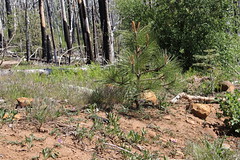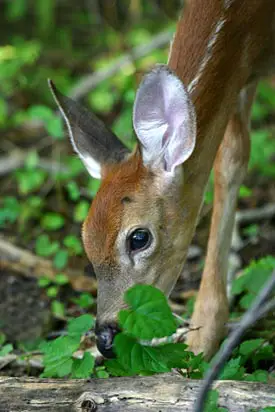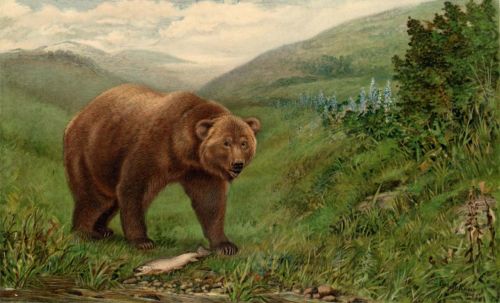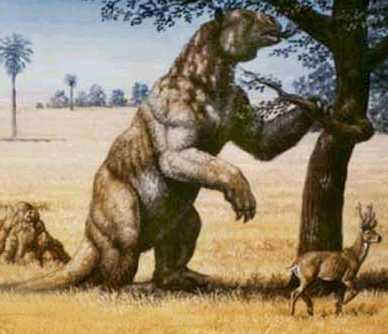
This is a continuation of the PART I article dealing with utilizing native ecological infrastructure as it is meant to be engineered after a major land disturbance and in the process rebuilding through a series of important step by step processes which will eventually lead back to a pristine biodiverse ecosystem which originally existed on any plant community location.
Habitat Restoration Using An Already Existing Ecosystem's Blueprints as a Basis for Design
 |
| photo: Mine |
Let's go back and compare two photos from Cuyamaca State Park pine seedling growth and notice the differences. The first picture is how they all start out no matter where they germinate.
But depending on the specific environmental conditions with which any seedling find themselves with regard to multi-species community of the protective nurse plant scheme cover or wide open range environmental situations, it can influence two radically differing growth patterns in nature. Take a look below at two entirely different growth pattern circumstances of the same species of pine tree. The one at the top is natural seeding in the open. Notice the stout structure with numerous branches ? Notice the second photo where brush has been mistakenly or irresponsibly cleared in an misguided effort to weed out the perceived choking competition of chaparral. This is truly a Rookie mistake. Notice the leggy appearance which for the most part has fewer branches than the top photo above it ?
 |
| Chaparral Institute |
 |
| Add caption |
Think of these little guys to the left as Mentoring Mushrooms. Young humans need guidance and mentoring in order to succeed and become healthy productive adults later on in life, so why not the young plants in a forest circumstance ? So what exactly are some of these componants that creates a successful old growth forest for which when you walk through it on a nature hike has the look of park-like setting ? Well, in this day and age it takes people understanding how the engineering works and for the most part not trying to force it before it's ready because we think we know what is best. In many cases it may mean hands off. At least if all the proper mechanisms are still in place. If not then some hands on may be necessary. Certainly these things will not happen over night, but they can look great after only a decade or so if we know the right areas to enhance, tweak and guide in the development.
Take a look at this photo below and the following website link. It clearly illustrates and helps one visualize that the Cuyamaca Mountains and other pristine wilderness areas were far more biodiverse than just mere conifer forests which is almost always the focus with most all tree planting restoration projects. It was tough finding an actual photograph of Cuyamaca which were pre-2003 Cedar Fire. What I remember most about the Cuyamaca Mountains is that they were not just a bunch of coniferous forests, but was an old growth example of almost every type of So-Cal native forest tree imaginable creating a healthy lush growth which provided a biodiversity for wildlife of every sort. The Garner Valley Jeffrey Pine Forest example above has no such variety, but it very well could and actually did have in the past. Take a look at the UCSD - San Diego Wildfire Educational Project page:
Take a look at this photo below and the following website link. It clearly illustrates and helps one visualize that the Cuyamaca Mountains and other pristine wilderness areas were far more biodiverse than just mere conifer forests which is almost always the focus with most all tree planting restoration projects. It was tough finding an actual photograph of Cuyamaca which were pre-2003 Cedar Fire. What I remember most about the Cuyamaca Mountains is that they were not just a bunch of coniferous forests, but was an old growth example of almost every type of So-Cal native forest tree imaginable creating a healthy lush growth which provided a biodiversity for wildlife of every sort. The Garner Valley Jeffrey Pine Forest example above has no such variety, but it very well could and actually did have in the past. Take a look at the UCSD - San Diego Wildfire Educational Project page:
This first photo is on a hiking trail going up to Cuyamaca Peak looking down on Stonewall Peak across the valley. Notice not only the conifers, but also the great variety of other broad leaf trees both deciduous and evergreen. One thing that often mistakenly happens when rebuilding a forest here in the west is that only conifers will be considered when it comes to replanting. Broad leaf trees in my opinion are equally as important and in many cases more so for the fact that they are often more deep rooted than conifers and will actually support the conifer regrowth by means of hydraulic lift and redistribution of water deep within the subsoil when it counts during the hot dry days of summer through the mycorrhizal grid.
I believe this is both Middle and North Peaks which are a part of the Cuyamaca Park system and this picture is prior to the 2003 Cedar Fire. Below is a picture of the same area after the devastating 2003 Cedar Fire. What a contrast. In an instant, a Hunter lights a fire on a day of extremely dangerous Santa Ana windy weather conditions. His fateful decision change the face not only of Rancho Cuyamaca State Park forever, but 11 people lost their lives as a result of being burned to death from being trapped by rapidly racing flames that could not be out rub.
The only other areas besides Cuyamaca State Park with the potential for such great diversity of life that I know of in San Diego County would be Palomar Mountain. [but even that has been attacked by fires caused by human stupidity] In Riverside County just north of there, the area of the San Jacinto Mountains in the North Fork San Jacinto River upper drainage basin for which Hwy 243 travels through from Banning to Idyllwild CA is very rich in a wealth of biodiversity. This obsession with failed conventional science-based monoculture replacement is killing our planet's natural world and whether people believe it or not also it's physical characters like climate and geological factors.
San Diego Rural Areas Prior to 2003 Wildfires
Other important lessons can be learned from how a forest environment truly functions and gradually creates or re-creates itself. Unfortunately this tiny bubble of the average human lifespan tends to want and demand instant success or results now. I understand that completely. I often am pressured by my own human weakness of wanting things now when putting a landscape together in a yard where even an impatient client may want results quickly. It's a matter of human nature. That's why I often opt for 1 gallon plants as opposed to 5, 10 or larger containerized plants and it's a tough sell to clients with lack of vision. However, in such urban settings you can quite often get away with it. But some things as putting forests back together again need natural processes to work in a precise numerical order of events and this may take some time in accomplishing.
Take a look at some pics I took over here just outside of my house on a trail leading from home to the Trolley stop. Take notice first of two completely different environmental factor situations under which a Norway Maple will grow.
 |
| photo: Mine |
The exact same thing could be observed of the Oak Tree (Quercus robur) which is also more commonly found performing beautifully in an understory of Mother Trees as opposed to an open environment situation where multi-branching is the case as opposed to strong slender truck development which in the long run produces the better lumber quality tree. First is an example of a parent tree in these woods and there are not many. The next photo below shows the numerous juveniles planted by means of wind blown seed which flutters on the wind like little propellers far away from the original parent tree. Literally thousands of them will germinate, but with so much competition only a few will make it.
Now the many young oaks which are being trained by all the adults.
Yeah Yeah , I know, but I swear there's a ton of them (Oak Saplings) in there among the other plant vegetation. It's the kind of place you have to experience first hand. But you know, there were seriously lush locations like this in the Cuyamaca Mountains with Black & Interior Live Oaks. But wait, there is another important component I've not even touched on.
Nature's original Social Networkers - Animals
 |
| Social Networking! |
 |
| Wildlife's major role. |
 |
| Mature Prunning |
Of course in Sweden and I imagine other northern regions in North America, the Moose & large Elk plays a huge role in opening up dense forest understorys. It's unfortunate however, that Industrial Forestry is contributing to the elimination of even their once historical range. Very few are seen in the numbers they once were around the area I reside. In almost ALL of the industrial forest land applications such animals are not to be found. The vegetation is so dense that even birds and squirrels cannot even be found there let alone a giant Moose by comparison.
Richard Halsey of the California Chaparral Institute based in Southern California writes on his website of the contributions of the now extinct California Grizzly Bear. Not necessarily in the forested habitats, but that of the Chaparral Community. Rick Halsey has shown examples of what could have been former Cal-Grizzly game trails. One has to wonder what truly has been lost with this animal's present absence!
But then I also wonder about the possible role that the now extinct Giant Ground Sloths may have had as a residence of these Chaparral or Savanna habitats of the Southwest and beyond. How would they have shaped an ecosystem ? Does the environment really suffer as a result of their loss ? If they were around when even the early Spanish Explorers came to North America, [there is some serious evidence found recently from old Spanish outpost or fortress garbage pits to suggest Sloth animal bones among the others were present] they certainly would have been easy pickings as a human food resource if their name is any indication of their possible quiet docile nature ? Even the pic above illustrates a potentially important role of such an herbivore in Oak Woodland habitats. It is said to have even dieted on Joshua tree and Mormon Tea, both fairly rugged plants for any herbivore to assimilate and process. Yet evidence found in Arizona Caverns which have been found to be former Ground Sloth dens were found to contain large amounts of mummified dung from these animals which amazingly revealed their diet. Still, it makes one wonder, what was their place in the natural world and how did everything else around them benefit from their presence ?
What about contributions of Pronghorn Antelope being at one time in the Southwest ? The list is endless as is the speculations of what once was and could have been now.
The real observation here should be on learning exactly just what any of these animals do, did and accomplished when it comes to shaping our natural world around us and the making of practical applicational uses by Urban Landscapers, Home Gardeners and most certainly large Agricultural Operations. For the the first two there is hope, but the last category is a bit scary. Great landscapers have been replicating what they see in nature for a long time now. [notice I reference great landscapers, not all are great, some still old school]
More and more Home Gardeners are becoming disenchanted with the ways big business and big government have been handling matters from a health standpoint and are taking matters into their own personal hands - 'Good for them'!!
Some other reading of personal interest and reference:
"A Sci-Fi Classic That's Become Today's Reality"
When Ideology Becomes Nature: 'The Pulp Fiction of Industrial Forestry'
Fire Adaptated Ecosystems: An Ideology That Misrepresents Nature











No comments:
Post a Comment
Thanks for visiting and stopping by with your comments!
I will try to respond to each comment within a few days, though sometimes I take longer if I'm too busy which appears to be increasing.